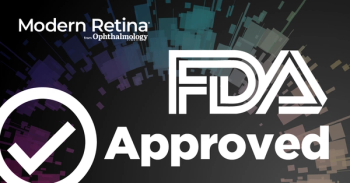
Kristina Pfau, MD, FEBO, discusses her research using high-resolution OCT to examine PXE patients, and more
Dr. Kristina Pfau discusses her research on pseudoxanthoma elasticum and the initiatives of EURETINA's Young Ophthalmologist and Retina Specialists Committee.
Kristina Pfau, MD, FEBO, a consultant ophthalmologist from the University of Bonn, caught up with Modern Retina during the 2025 European Society of Retina Specialists (EURETINA) meeting to discuss her research and involvement with EURETINA's Young Ophthalmologist and Retina Specialists (YOURS) Committee.
Pfau highlighted her research using high-resolution OCT to examine pseudoxanthoma elasticum (PXE) patients, revealing significant insights into retinal changes. Pseudoxanthoma elasticum (PXE) is a rare genetic disease that shares similarities with age-related macular degeneration (AMD).
The discussion explored the genetic basis of PXE, focusing on the ABCC6 gene and potential therapeutic approaches targeting pyrophosphate levels to prevent calcification. Pfau also stressed the systemic nature of the disease, recommending comprehensive medical care that extends beyond ophthalmology.
Additionally, Pfau also gave an overview of the YOURS Committee's activities, including educational initiatives like mystery case sessions, science labs, and webinars. The committee aims to support young retina specialists through professional development, networking, and access to resources, including a preparatory course for the European Board of Ophthalmology (EBO) retina subspecialty exam.
Editor's note: This transcript has been lightly edited for clarity.
Kristina Pfau, MD, FEBO: My name is Kristina Pfau. I'm a consultant ophthalmologist at the University of Bonn, and I'm also one of the committee members of the YOURS Committee, which represents the young retina specialists within EURETINA.
My research focus is a disease called pseudoxanthoma elasticum, which is a rare disease, a genetic disease, and sometimes it has you have the same problems that you also have in age-related macular degeneration; [that's] why it's sometimes also confused. You have atrophy development, you have broadly rescuelization with exudation, but more importantly, there are several therapeutic options coming up in the next years, so we really need a good outcome measure.
Fortunately, we do have a high-resolution OCT in Bonn. So, what we did was we examined really early-stage PXE patients and looked at their high-resolution OCT, and what we found was that their Bruch membrane and RPE look completely normal outside of the calcified area. Within the calcified area, we did see significant changes to the RPE Bruch membrane complex. This is highly interesting, because if we can show over time that this changes, and we have a fantastic outcome measure for our future interventional trials.
Pseudoxanthoma elasticum is a genetic disease, and genetic diseases normally occur early in life. So you can already think of something genetic if you have a patient having AMD phenotype, but it's a lot younger than always. Think of differential diagnoses like pseudoxanthoma elasticum and so on. But sometimes also pseudoxanthoma elasticum is occurring late onset, so it can also occur as a first manifestation in older age, and then it can really look like AMD. It looks like AMD because they can get the neovascularization, atrophy, and you can treat them same as the AMD patients, but you really have to do multimodal imaging to detect the disease.
So really need a fluorescein angiography and a fungus autofluorescence to see the amyloid streaks. They are radiating from the optic disc. Then also, if you look at the fundus, you can see the calcified area in pseudoxanthoma elasticum that is confined around the optic nerve, and outside you have normal, uncalcified Bruch membranes. So you have really a whitish area in the center and the red area in periphery. So if you look closely at your multimodal imaging, then it should be distinguishable. But beware that this can really look like AMD.
That is super interesting, because the gene is just 1 gene, so it's ABCC6, and that encodes for a transporter in the liver. We don't know yet exactly what the transporter does, but what we know is that in the blood of these patients, pyrophosphate is decreased. All targeting options now try to increase the level of pyrophosphate in the blood, either by substituting it or by inhibiting the degradation so that you actually keep your own pyrophosphate longer active, and pyrophosphate, then, if it's high enough, actually inhibits calcification. So we really try to increase the pyrophosphate level in the blood of these patients.
Yes, if you have a patient with PXE, always think that it's a systemic disease, and you, as an ophthalmologist, can really make a difference. You have to send them to an angiologic center, because they get classification of arteries and the heart. So they really have to go-to check up and also be in the care of a general specialist and angiologist.
YOURS is having YOURS Saturday, YOURS day, and that's always, every year contains 4 sessions, which is the mystery cases, where young retina specialists present their most interesting cases in a mysterious way. So you can guess and kind of try to do your best and solve them. Then there's a science lab where four very talented speakers actually prepare their research in a funny way. I can, I can already disclose that this will be super funny this year. Then there is the rising star session, which used to be the symposium where advanced career stage young specialists present their research of the last year. Some more an overview, which can be very interesting. Then there's the Ophthalmologica lecture, which is a prize given by the Ophthalmologica, which is a journal. We can propose someone for this lecture. This year, it's Maria Vittoria Cicinelli from Italy.
We try to do activities all year round. Of course, the Congress season is our main focus, but we do have webinars. We do have podcasts. There have been several interesting podcasts by YOURS members about their experience and fellowships by experience of going abroad. We do always a case club webinar. So we present our cases that we find all year round, and discuss them with the audience. And then, of course, there's online material that you can have access to, and being yours member has the advantage that you have 3 years free membership to EURETINA, so you really can get all the access and all the advantages of a full EURETINA member.
So the EBO retina exam is a subspecialty exam, which you can take after certain experience in the field of retina and after you've taken your normal EBO exam, and we as young retina specialists wanted to do a course to prepare on the topics.
This has evolved in the last year. So in the first year, it was quite a mix of topics, because, of course, we weren't given the questions and so on, but now we have some experience, and now it's really an interesting session, also for people that don't want to take the exam or don't want to sit the exam, but for everyone.
We have 8 sub-specialty sections in EURETINA, and we always cover 4 of them in 1 year and 4 in the other year. The sessions are super interesting because we, as young retina specialists, we kind of ask them to always lead a chair by 1 expert and 1 young retina specialist. So they are paired like 1 maybe older and 1 younger chair.
So you can get both perspectives. You can get perspective of the professor who maybe overlooks the whole area, and then maybe some sneak peeks from somebody who's just taken the exam and really can help you in the preparation and knows how the situation for the attendees.
Newsletter
Keep your retina practice on the forefront—subscribe for expert analysis and emerging trends in retinal disease management.
















































